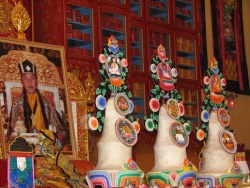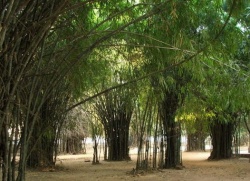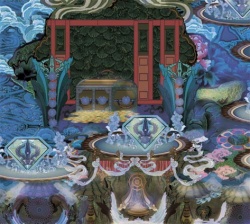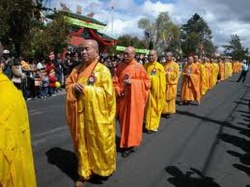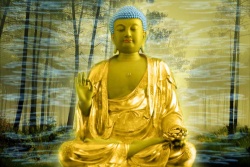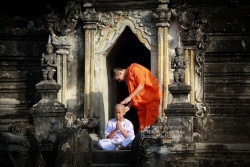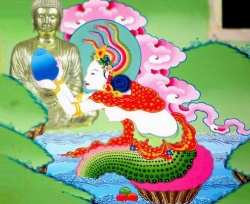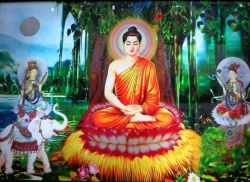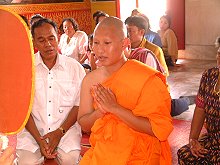The Practice Of Buddha Tsonchei Mijigpai Gyalpo
The Practice Of Buddha Tsonchei Mijigpai Gyalpo
Prescribed by Padmasambhava to Awaken Bardo Beings from Intense Fearful Illusions Arising from Death in War, by Weapons, and in Accidents.
Special Practice Request/Transmission
Prescribed by Padmasambhava to awaken bardo beings from intense fearful illusions arising from death in war, by weapons, and in accidents
Please treat this text with respect as it is something beneficial to all, like a good medicine.
Precious Dharma Family,
Trillions of thanks for the love, compassion, and practices you are all doing for the suffering beings in our human family. I am so grateful for sharing this practice of Tsonchei Mijigpai Gyalpo which I think is the right practice for this time. The Vajradhara 8th Khamtul Rinpoche and Vajradhara Dilgo Khyentse Rinpoche stressed the urgency of this practice during these times of violence and war. Tsonchei Mijigpai Gyalpo means the supreme enlightened one who liberates bardo beings from the fear and terrifying illusions arising from death by weapons. I send all you practitioners my deep heartfelt gratitude and prayers for transmission blessings of these teachings directly from the Buddhas and from Gurus. It will surely be of immense benefit for all the dead since we are doing it with very profound and pure loving motivation, free from any partiality.
I ask all Buddhists to practice this to help the dead from all sides and to protect the innocent.
With much love and gratitude,
Choegyal Rinpoche
The practice of Buddha Tsonchei Mijigpai Gyalpo, Buddha Akshobhya, and Vajrapani to help those who have died in accidents and especially those who have died from weapons
Taking Refuge (three times):
NAMO RATNA TRAYAYA
I take refuge in the Tathagata Tsonchei Mijigpai Gyalpo, the Tathagata who liberates bardo beings from all fears and illusions arising from death by weapons.
I take refuge in the Tathagata Akshobhya.
I take refuge in Vajrapani.
Please pacify all the fears of those who have died in accidents and in war.
Arousing bodhicitta, the enlightened attitude (three times):
To obtain Buddhahood for the benefit of others, I generate bodhicitta, as aspiration, as action, and in its absolute meaning.
- Then meditate, further developing supreme compassion and equanimity. Here it is helpful to contemplate the four immeasurables and especially to visualize oneself as Avalokiteshvara and to recite his mantra of compassion, OM MANI PADME HUM, a suitable number of times.
- When you are confident in your generation of profound love and compassion free from partiality, continue with the visualization and prayers below, feeling the dead beings in your mind.
Visualization and prayers:
Visualize the minds of those who have died in accidents and from weapons as blue balls of light, each enclosed by a sphere of violet light. While reciting the prayers and mantras below, the violet spheres disappear and the minds, visualized as blue lights, are freed.
Repeat each section below a suitable number of times. Include gaps to develop vows, feelings, visualizations, etc.
Prayer To Buddha Tsonchei Mijigpai Gyalpo
CHOMDENDHE DESHINSHEGPA DRACHOMPA YANGDAGPAR DZOGPEI SANGYE TSONCHEI MIJIGPAI GYALPO LA CHAKTSAL LO, KYABSU CHIO. JINGYI LHABTU SOL.
Translation:
Bhagawan, Tathagata, Arhat, Perfect Buddha, The One who liberates bardo beings from all fears and illusions arising from death by weapons, we prostrate to you. We take refuge. Please bestow your protection and blessings to all who have died in this manner.
Dharani Of Buddha Akshobhya
NAMO RATNA TRAYAYA OM KAMKANI KAMKANI ROTSANI ROTSANI
TROTRANI TROTRANI TRASANI TRASANI PRATIHANA PRATIHANA SARVA
KARMA PARAMPARA NIME SARVA SATO NANYATSA SOWHA
Mantra Of Vajrapani
OM VAJRA CHANDRA MAHA ROSHANA HUM PHAT,
OM APRATI HATA VALA HUM PHAT,
SARVA BHIGHANAN ANTARAYA VINASHKARA MARAYA HUM PHAT.
The whole of existence is perceived as filled with the FIVE WISDOM LIGHTS, the luminous radiance of the fearless wisdom, love, and compassion of the Buddhas.
Rest the mind in its uncontrived state.
- Remind these bardo beings of important dharma points, especially that all phenomena are illusory including our concepts of living and dying. Remind those who were practitioners of the Buddhadharma to think of Buddha Amitabha and encourage them to go to his pureland. Buddha Amitabha has a special vow to bring whomever prays to him to the pureland.
Dedicating the merit:
Conclude the session by dedicating the merit to all sentient beings wandering in samsara, enduring sufferings of all kinds. May each and every one be free of wrongdoings and illusions; following the path to supreme liberation, may they become filled with boundless joy, happiness, and wisdom.
Recite:
May the hail of lava, fiery stones, and weapons
Henceforth become a rain of blossoms.
May those whose hell it is to fight and wound
Be turned to lovers offering their flowers.
May forests where the leaves are blades and swords
Become sweet groves and pleasant woodland glades.
On every side and in all the ten directions,
May groves of wish-fulfilling trees abound,
Resounding with the sweetness of the Teachings,
Spoken by the buddhas and their bodhisattva children.
- -Shantideva - Bodhicaryavatara (from 10:9,6,34)
Cultivate bodhicitta in all daily activities and interactions with others with unwavering aspirations for an end to aggression and confusion on all levels.
Brief Background and Commentary
This practice from Dugu Choegyal Rinpoche 8th is based upon oral teaching instructions of Vajradhara 8th Khamtul Rinpoche and of Vajradhara Dilgo Khyentse Rinpoche. It is according to the Rinchen Terdzod Gridul, the AKSHOBHYA SUTRA, and the Zungsnatsog of Jamgon Mipham Rinpoche.
This prayer to Tsonchei Mijigpai Gyalpo was taught by Padmasambhava for the beings of this dark age whom he prophesied would suffer intensely upon dying in wars and in accidents. The terma was revealed by Lhodrak Drubchen Lekyi Dorje and is preserved in the Rinchen Terdzod in volume Ni, known as Gridul.
In this teaching, Padmasambhava said that unless we help to free these bardo beings from the fears arising from the violent circumstances of their death, their mindstreams will become trapped in recurring cycles of longlasting, terrifying, fearful illusions and they will be unable to establish and stabilize clarity of mind.
The Akshobhya mantra has been added to the practice for destroying karmic effects and this special Vajrapani mantra for giving protection and fearlessness to the living and to these bardo beings.
May this teaching spread around the whole world so that in these times of war the mindstreams of the dead will become free from fearful illusions. By the merit of this teaching and practice, may the loving and compassionate quality of their minds arise with clarity so that they will be reborn in a peaceful world, in heaven, or in Buddha fields.
Mangalam
This precious text is the property of all.
Please share it (complete and unmodified as included here) with Dharma practitioners around the globe so that it may be of maximum benefit.
Notes on The Practice of Tsonchei Mijigpai Gyalpo
edited from Rinpoche's comments, instructions, and answers to questions
- The urgency for this practice is greatest during the first 3 days following death because the shock and fear are so fresh and intense. During this time, frequent practice is strongly recommended. It is important to continue this practice throughout the bardo period, 49 days on average.
- It is especially beneficial to accumulate merit between sessions of this practice, for example by making offerings, connections with stupas, and so on.
- It is also very helpful to use the Tibetan Book of the Dead.
- Distance between the practitioner and the site of death is not an obstacle to this practice; distance is nothing to those who have died.
- By bringing to mind those who have died in a particular war, act of violence, or accident, we establish a karmic connection through which they receive the benefit of this practice. Thus it is no obstacle that we did not previously know these people. Through this karmic connection
- This practice is equally beneficial and appropriate for all, regardless of religious beliefs. The Buddhas and Bodhisattvas are free from any partiality in their compassionate activities.
- This practice is particularly beneficial for humans who suffer sudden violent deaths because the human brain and nervous system is extremely sensitive and highly inclined to illusion, even after death.
- This practice may be used for those who have taken their own lives as well as for those who have died from weapons, in war, or in accidents.
Additional Sources
- The revealer of this terma, Lhodrak Drubchen Lekyi Dorje, was a great Nyingmapa master. He was highly accomplished, especially in the practice of Vajrapani, and was a principle teacher of Rje Tsongkhapa Chenpo. He received teachings directly from Vajrapani and is highly respected by all Buddhist schools in Tibet. Lhodrak Drubchen Lekyi Dorje means Vajra of Action, the Siddha from Lhodrak (his birthplace in southern Tibet).
- The bodhicitta vow is from The Excellent Path to Enlightenment by Dilgo Khyentse Rinpoche. He reminds us that the main obstacle that has prevented us from generating bodhicitta in the past was the distinction we made between friends and enemies.
- Shantideva’s verses above from the Bodhicaryavatara are cited from The Way of the Bodhisattva, Shambhala Editions.
Source
[[Category:]]
